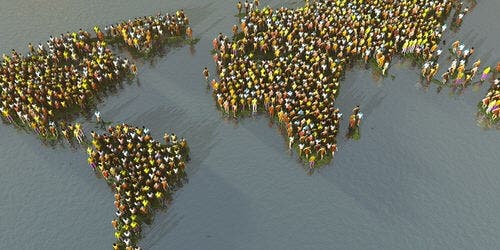There’s no secret to anyone, I believe, that the world is over-crowded right now. By the end of 2011, according to the U.N., the world population is set to reach a solid 7 billion, a billion more than in 1999. The United Nations, who’s been providing highly accurate population projections decades ahead, however warns that by 2100 human population will hit the 10 billion mark.
The explosive census growth can be traced back to the beginning of the industrialization era, when the quality of life dramatically increased, allowing for an increase both in life expectancy and number of births. Thus, by 1800 the world population reached its first billion, that we known of – 125 years later, the figure doubled. In the last 50 years alone, the population boomed from three billion to six.
Between now and 2050, the U.N. estimated 2.3 billion more people will be added, while for 2100 projections range from 6.2 billion to 15.8 billion (yes, the U.N. also foresees the possibility of a dramatic population decrease). The real problem, however, might be more severe due to to social reasons than resource-wise. Ninety-seven percent of the projected population increase over the next century is expected to happen in developing nations, according to a review article in Science by David Bloom, of the Harvard School of Public Health in Boston. Nearly half of the growth will be in Africa.
“Every billion people we add to the planet makes life more difficult for everyone and will do more damage to the environment,” said John Bongaarts, a demographer at the Population Council, a research organization in New York City. “Can we support 10 billion people? Probably. But we would all be better off with a smaller population.”
This means, that only an insignificant percent of the projected next 3 billion people to inhabit the planet by the turn of the century will be from the developed world. Currently, if each woman on Earth would give birth to exactly two babies, the population should remain stable. Today, there is a global average of 2.5 births per woman – down from five in 1950.
In Japan, China and Europe, women are having fewer than two babies, while in less developed countries the average is around five. As such, developing countries will experience even more difficulties in managing thin resources, food or water supplies and handling economics.
“The demographic picture is indeed complex, and poses some formidable challenges. Those challenges are not insurmountable, but we cannot deal with them by sticking our heads in the sand,” says Bloom.
“We have to tackle some tough issues ranging from the unmet need for contraception among hundreds of millions of women and the huge knowledge-action gaps we see in the area of child survival, to the reform of retirement policy and the development of global immigration policy. It’s just plain irresponsible to sit by idly while humankind experiences full force the perils of demographic change.”
The coming population explosion will be bad news all across the globe, putting strains on space, labor and the environment. A number of solutions have been discussed inside and out of the U.N. for a lot of years now, with a common viable solution of proper family planning priming in the discussion boards. Sex education and access to contraceptives might make a huge difference, especially in regions like Africa where the young population is alarmingly high.



